How Long Must a Spill Be on the Ground for a Store to Be Liable for Slip and Fall Injuries?
Our firm recently settled a slip and fall case for a Monterey resident who fell at a Salinas gas station. Specifically, the client slipped and fell while exiting his vehicle at a gas pump. The previous customer had spilled gasoline on the ground. As a result, when the client stepped out of his vehicle, he encountered a slick surface and fell.
The client was elderly and severely injured. He tore multiple tendons in his left shoulder. The injury required surgery to repair and the installation of several screws.
The client contacted us early on and shortly after the fall. We agreed to represent him and arranged for an evidence preservation letter to be delivered to the business. The letter put the business on notice of the fall and specifically requested that it save any video surveillance footage.
We settled the case for $50,000. This typically would not be a good result for the injuries the client sustained. However, the result was remarkable under the circumstances. Under the law, the gas station was not legally liable and if we pressed the case further, we would have lost. This is because the evidence showed that the spill had only been on the ground for less than eight minutes when the client fell.
Details about the Slip and Fall Incident
On February 14, 2022, at approximately 3:00 P.M., the client pulled his truck into the Pilot gas station located at 951 Work Street, Salinas, California. Like every other time he had visited this gas station, the client drove his truck next to a gas pump so that he could fill his vehicle. When the client stepped out of his vehicle at pump #8, his left foot slipped forward from underneath him.
This caused him to fall onto the concrete. His left shoulder made contact with the ground and absorbed the brunt of the fall. The client hit the ground hard and felt immediate pain.
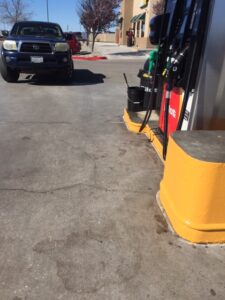
The client remained lying on the ground for several minutes waiting for an employee to come to his aid. Unfortunately, no employee was paying attention or monitoring the area. No one came out to help him. Eventually, the client was able to gather himself and went back into his truck. He then drove home so he could assess the extent and severity of his injuries.
The Extent of the Slip and Fall Injuries
When the client arrived at his home, he noticed a tremendous amount of swelling in his left shoulder. The area also appeared to be deformed and was completely immobile. Concerned for his health, the client scheduled an appointment with his medical provider. The client was seen the following day.
At the medical appointment, the client complained of severe shoulder pain and was still unable to move his left arm. He was assessed by a physician who ordered an MRI of his shoulder. Unsurprisingly, the diagnostic imaging showed that the client had sustained tears to several major ligaments in his shoulder.
The client sustained a traumatic full-thickness tear of the supra and infraspinatus tendons. He also sustained a partial tear of the upper border subscapularis tendon and subluxated his biceps tendon. His rotator cuff was retracted nearly to the glenoid. The client’s condition was deemed serious and emergent. As such, he was referred to an orthopedic surgeon to have his injuries assessed further.
The Surgery and Treatment for the Slip and Fall Injury
Two weeks after the fall, the client underwent a left shoulder arthroscopy with arthroscopic repair of his massive rotator cuff. This was a major procedure. The client was placed under general anesthesia.
Hardware was installed in his shoulder including multiple anchors into his bones to rebuild his damaged ligaments. Several incisions were made on his shoulder during the surgery which required sutures to close. After the surgery, the client was placed in a large splint and was given a variety of medications to control pain and to prevent infection.
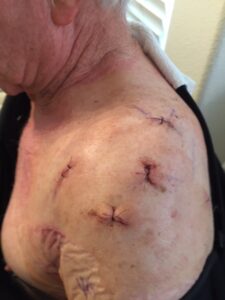
The client then underwent 25 sessions of physical therapy. He had difficulty sleeping and doing all activities of daily living. Eventually, he recovered but the road was long and difficult.
The Evidence Showed the Spill Was Not on the Ground Very Long
After we agreed to represent the client, we sent the gas station a demand letter. Our demand letter sought compensation for our client’s injury. At the time we sent the letter, we were unsure what our client fell on or why the surface was slippery. Shortly after, we were contacted by an attorney who represented the gas station.
The attorney claimed that a previous customer had spilled gasoline on the ground. The attorney offered to show us the video surveillance. Sure enough, the video surveillance showed another customer spilling gasoline on the ground before our client’s arrival.
We were lucky to have reviewed the footage. The footage proved that our client actually slipped on something dangerous. However, the video also showed that the spill was not there very long. As a result, the gas station was likely not legally responsible.
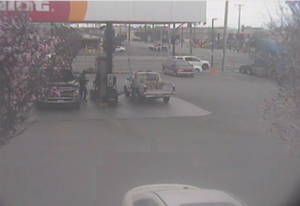
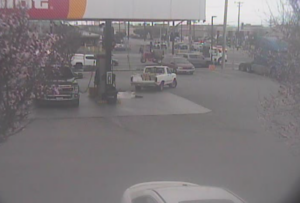
When is a Business or Store Owner Responsible for a Customer’s Slip and Fall
Under California law, a business or store owner is not the insurer of the safety of its patrons. In other words, just because you are injured on the premises of a business or in a store does not mean the business owner is responsible. A business or store owner only needs to exercise reasonable care to prevent injuries to its patrons—they do not have to safeguard against all injuries.
A business or store owner only needs to exercise reasonable care to prevent injuries to its patrons—they do not have to safeguard against all injuries.
In the slip and fall context, this means that a store or business owner must remove dangerous conditions that they are aware of or should be aware of. This means that they must clean up spills within a reasonable amount of time. This also means that they must find the spills in a reasonable amount of time as well.
To be clear, a dangerous condition, that someone can slip and fall on, is more than just a spill. In a grocery store, someone can slip and fall on produce on the ground. Of course, the quintessential example would be a slip and fall on a banana peel.
In a construction or home improvement store, sawdust on the ground could create a dangerously slick condition. In an autobody shop, oil or transmission fluid on the ground could create a slip and fall hazard. In a fast food restaurant, ice by a self-serve soda machine could create a dangerous hazard.
How Does a Business or Store Owner Exercise Reasonable Care?
Under California law, a store owner exercises reasonable care by making reasonable inspections of the portions of the premises open to customers. The care required is in direct relationship to the risks involved. If the business is a self-service grocery store where the customers are invited to select and replace goods on shelves, then more care may be required. In that setting, it is anticipated that more spills may occur as customers drop items on the ground.
Grocery stores usually require visual floor sweeps every 15 minutes or more. During these sweeps, employees look for spills and slip and fall hazards. These sweeps are documented in a log where the employee who performs them writes down when the sweeps were completed.
This is a basic safety practice used by every major grocery store in California. If a store does not employ this practice, or if the sweeps are missed, then the store could be held liable for a dangerous condition. Also, certain areas of the store may require more frequent sweeps than others. This would include high traffic areas and areas where a lot of items tend to fall on the ground—like the produce section.
At Least Ten Minutes is Needed for a Store or Business to Potentially Be Responsible
At least one court has weighed in on the amount of time needed for a spill to exist and go undetected before the business will be held responsible. In Alacan v. Target Corporation, a patron at a Target Store slipped and fell on chocolate milk. A store employee passed the area where the patron fell 5-7 minutes before her fall actively looking for spills and debris on the ground. The employee did not see the chocolate milk spill as it was not yet on the floor.
The Court held, that as a matter of law, the case could not proceed further against Target. The Court concluded that no jury could find that a store owner was responsible for finding a spill that was on the ground for less than 5-7 minutes. The court stated that the “negligence premises liability action fails because a store owner’s inspection within 7 minutes of the fall does not constitute a breach of the duty of care.”
In reaching its decision, the court reviewed rulings from other California courts on the issue. The court set forth that its ruling was consistent with the others. Noting “nothing less than thirty minutes between the last inspection and a plaintiff’s fall has been held to raise a genuine dispute of material fact or sufficient to uphold a plaintiff’s verdict.”
However, Alacan v. Target Corporation was decided in 2015. In 2021, another decision was issued out of the same district court. That case was entitled Romero v. Wal-Mart Stores, Inc.
In that case, a customer at Wal-Mart slipped and fell on soda by a self-service machine. The spill was in a high-traffic area. The court noted that 165 customers and 18 employees had passed through the area in fifty minutes.
The spill in Romero was only on the ground for 10 minutes and 39 seconds. The court held that it could “not conclude as a matter of law that 10 minutes 39 seconds is too short a period to charge Wal-Mart with a lack of ordinary care for failing to discover a soda spill in a high traffic area.” As a result, the court allowed the case to continue on and the customer to present the claim to the jury.
The Two Main Factors Considered in a Slip and Fall Case
From the above cases, it is clear which factors the courts consider most important in a slip and fall analysis. The first is time. Specifically, the amount of time the spill or dangerous condition is on the ground.
It is clear which factors the courts consider most important in a slip and fall analysis. The first is time…The second is how many people traverse the area.
The second is how many people traverse the area. If the area is high-traffic, then more frequent inspections are required. With less people traveling through the area, it is reasonable for a business or store to conduct less frequent inspections.
What if the Spill or Dangerous Condition is Caused by the Store Employee?
The above only addresses spills that are caused by someone other than a store employee. None of the above applies is a store employee causes the spill. If a store employee causes the spill, then the store is directly responsible for any resulting injuries. This is true no matter how long the spill was on the ground.
The above sections also only apply if the spill goes undiscovered. If a store employee was to see the spill and then fails to clean it up, then the store would also be directly responsible. The analysis of how long the spill was on the ground would not be necessary.
The Factors Applied to The Slip and Fall Case We Settled
Applying the factors of time and amount of traffic to our client’s case shows that the settlement was exceptional. In our case, the spill had been on the ground for less than ten minutes. Making matters more difficult, was that spills of that nature are extremely uncommon. Simply put, people do not regularly pour gasoline on the ground when they are filling up their vehicles.
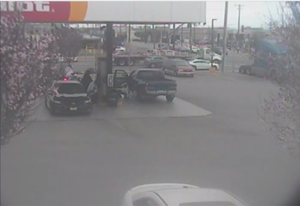
The unusual nature of the spill would mean that the gas station owner would not be expected to frequently inspect those areas for such spills. Unlike a grocery store, an inspection once an hour or every few hours would likely be found reasonable. Through skillful lawyering and knowing the case law better than the other side, we were able to reach a settlement on a case that we would have likely lost.
Contact a Skilled Personal Injury Attorney for Your Slip and Fall Case
If you or a loved one was injured due to the negligence of a store or business owner, contact one of our Monterey personal injury attorneys today. Our attorneys have dedicated themselves to personal injury law. They know the ins and outs and will make sure you have the best chance of recovering for your injury. A consultation is free and we only earn a fee if we recover money for you.
About the author: The content on this page was written by California personal injury attorney and civil rights lawyer Charles “Tony” Piccuta. Piccuta graduated with honors from Indiana University-Maurer School of Law in Bloomington, Indiana (Previously ranked Top 35 US News & World Report). Piccuta took and passed the State bars of Arizona, California, Illinois and Nevada (all on the first try). He actively practices throughout California and Arizona. He is a winning trial attorney that regularly handles serious personal injury cases and civil rights lawsuits. He has obtained six and seven figure verdicts in both state and federal court. He has been recognized by Super Lawyers for six years straight. He is AV Rated by Martindale Hubble. He is a member of the Consumer Attorneys of California, American Association for Justice, National Police Accountability Project, Arizona Association of Justice, and many local county and City bar associations.
Disclaimer: The information on this web site is attorney advertising and is for informational purposes only. It does not constitute legal advice. Reading and relying upon the content on this page does not create an attorney-client relationship. If you are seeking legal advice, you should contact our law firm for a free consultation and to discuss your specific case and issues.

